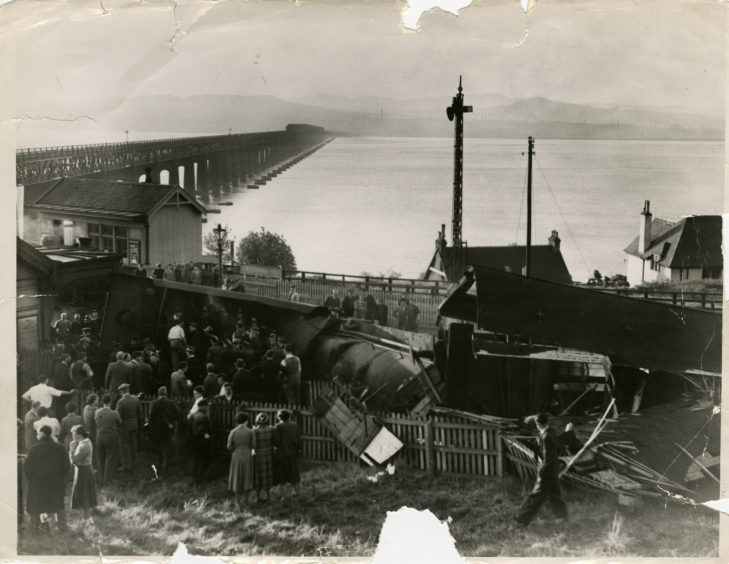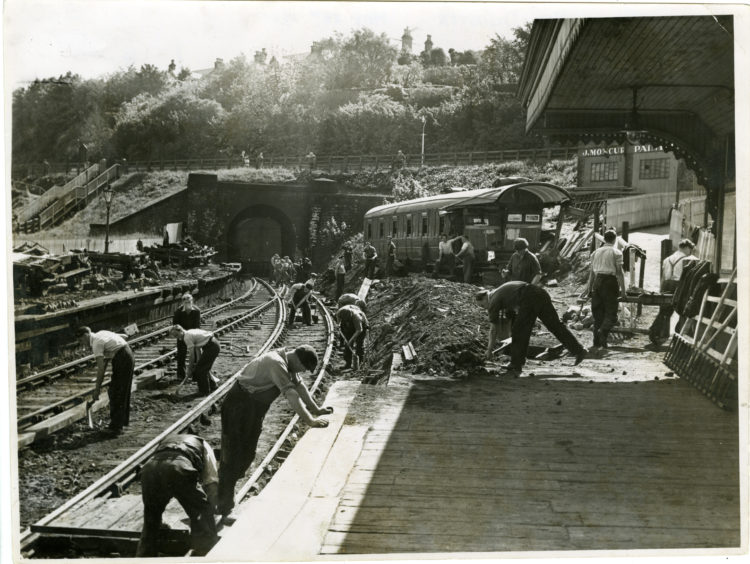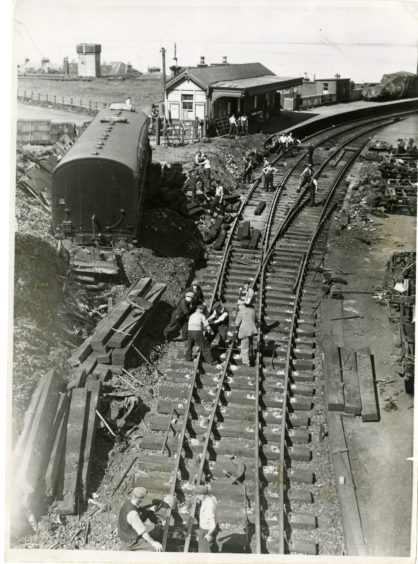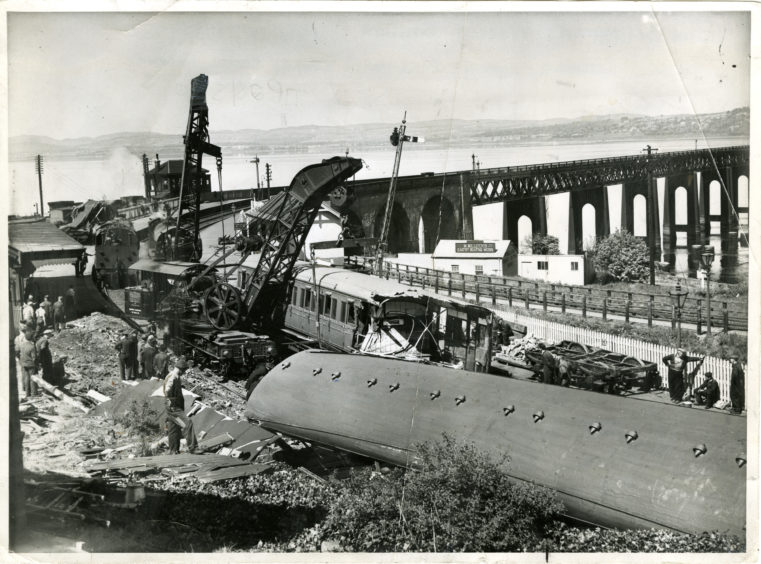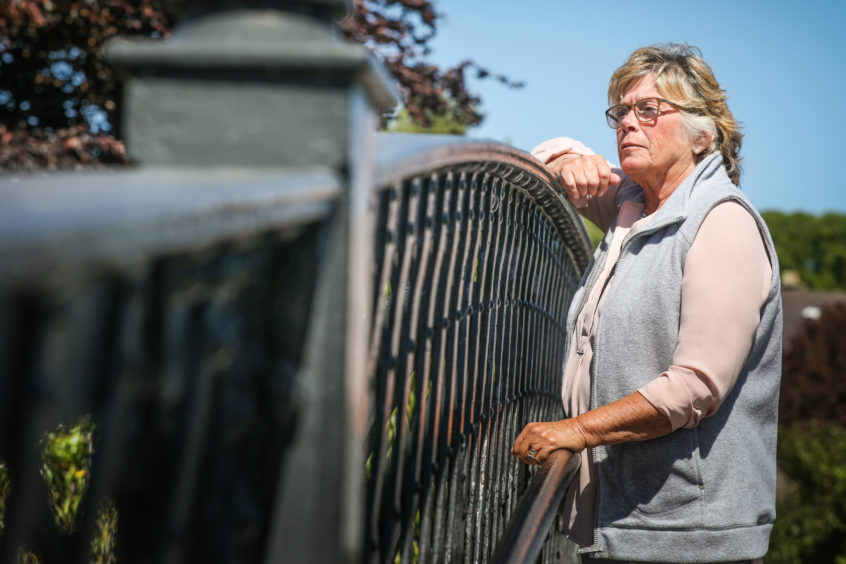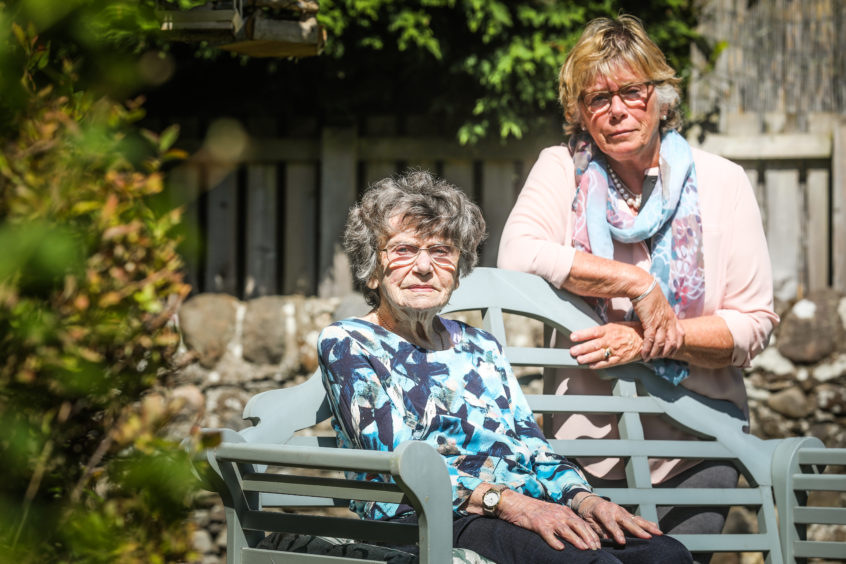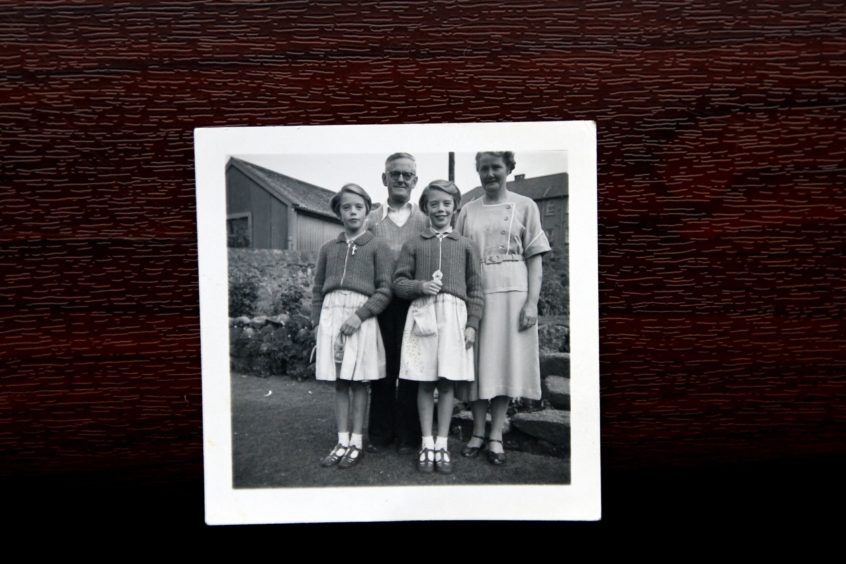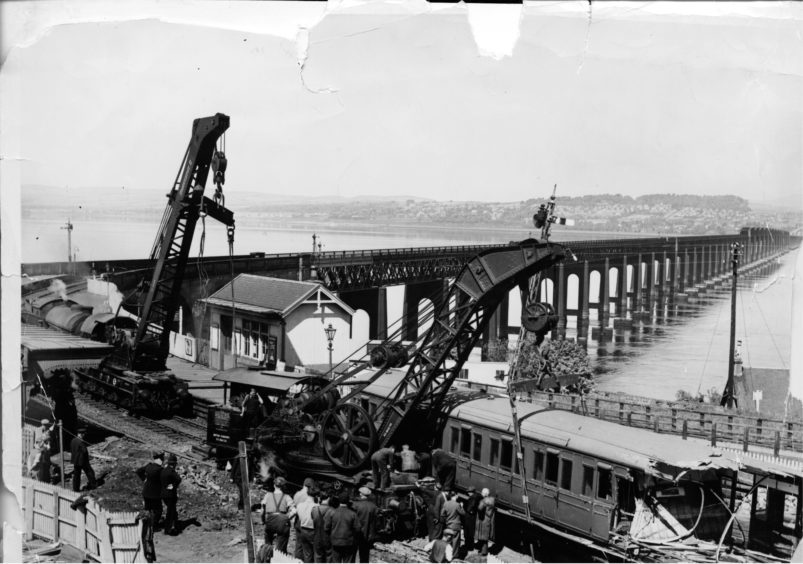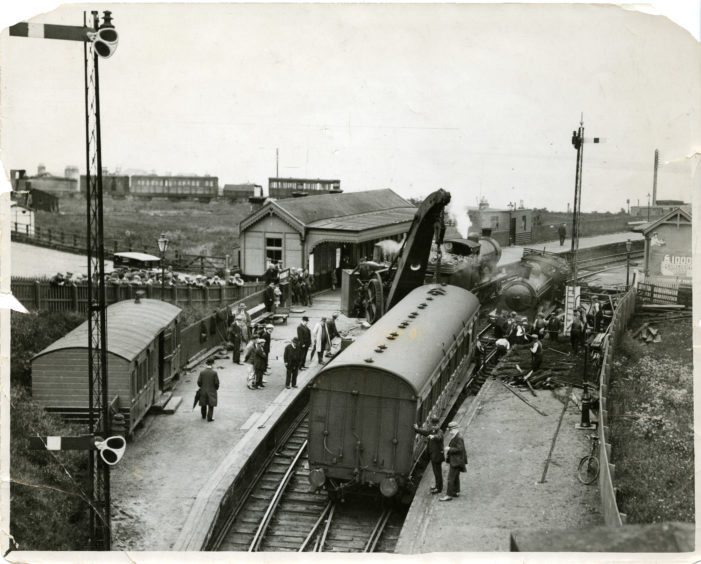It’s 65 years to the day since a steam train full of children ploughed into Wormit station, killing three people. Some of the crash survivors spoke to Gayle Ritchie.
As the speeding train hurtled through the tunnel, there was a sickening grinding, throbbing noise.
Passengers screamed in terror as sparks flew, lights went out and the train ploughed into the platform at Wormit station, derailing four carriages, killing three people and injuring 41.
There were 539 people on board – including 301 children, many of whom were returning home after having enjoyed a Sunday school picnic in Tayport.
The tragedy happened just after 7pm on May 28 1955 – 65 years ago today.
One of those killed was 10-year-old Ian Shaw.
The Dundee FC fan had been at the picnic with his seven-year-old brother and had asked the driver if he could stand on the engine’s footplate for the journey back.
The others killed were 39-year-old church elder Charles Harrower of Dundee’s Strathmartine Road and railway fireman John Cowie, 32, of Blackscroft.
Their bodies were found in the engine room covered in coal.
The driver of the train, Alexander Low, then 39, suffered burns and lost an arm in the crash.
He was cleared of culpable homicide by a majority verdict at trial the following spring, but an official Ministry of Transport inquiry said Low, who had been drinking alcohol, had acted with “sheer recklessness” and was possibly “showing off”.
Chaos and panic
Horrified onlookers at Wormit station witnessed the engine speeding out of the tunnel and ploughing into the platform, just yards from the Tay Rail Bridge.
The engine folded up like a concertina and overturned, blasting sleepers, brickwork and earth in all directions.
The guard’s van and two coaches were telescoped while the front of the guard’s van was thrust upwards.
Splintered woodwork and upholstery were scattered across the line.
Chaos and panic ensued when passengers, in deep shock, dragged themselves out of the coaches, many of them injured, in agony and covered in blood.
The smoke rising from the train could be seen in Dundee as news of the accident spread fast.
SOS
Passengers climbed across the four overturned carriages to the platform where they then huddled, traumatised.
Panicked parents who had heard about the accident headed onto ferries to reach Wormit.
Motorists and people who lived nearby stopped to help and transport injured passengers to hospital.
“There was black, black smoke”
Memories of the crash are still vivid for passenger Hazel Grieve who was just six years old when the disaster struck.
Hazel, now 71, had been on a Morrison Church Sunday school outing with her twin sister Heather, father Charlie Angus, who helped with the boy’s brigade, and mother Mary.
“I will never forget the noise and the black, black smoke,” says the grandmother-of-seven.
“It was so scary. I have vivid memories of the train overturning and of being buffeted about.
“Our carriage was upside down. It was in the air at a tilt. It was so disorientating.”
Hazel, who lived in Dundee’s Benvie Street at the time, recalls her father throwing her and Heather to the floor and shielding them from cascading debris.
“We were in complete shock. The screeching of brakes, the thick smoke, and then the thudding, banging and buckling until it settled, was horrendous.”
She also remembers being lifted out of a carriage window and being ushered over to an embankment. Here she and other children were comforted, wrapped in blankets and given sweets and drinks by members of the Red Cross.
Too traumatised to get on another train back home to Dundee, Hazel and her family instead took the Tay Ferry.
Prior to the crash, Hazel, who now lives in Monifieth, remembers having enjoyed a happy day out with friends and family members, including her uncle, a minister at the Morrison Church on Guthrie Street, and grandmother.
“It was a glorious day in May and we’d had a lovely Sunday school picnic with hundreds of other children,” says the retired childcare officer.
“We were all in a good mood coming back, and the train ride was a chance to reflect on the fun we’d had.
“Then all of a sudden, this horrendous, terrifying thing happened to us. It was unthinkable. But at least we hadn’t lost any family members or friends.
“It wasn’t really until years later that I actually thought about what could’ve happened, or how much worse it could’ve been.
“I saw photographs of the crash a few years ago and those images really shocked me.”
Even today, when Hazel goes across the Tay Bridge, she gets slightly anxious and fearful, saying she can “almost smell the burning and the soot”.
“That horrendous feeling never leaves you,” she adds.
“I always think if I was blindfolded on that train journey, I would know when I reached the spot where it crashed. I would be aware of it.”
We were in complete shock. The noise of the train screeching, the thick smoke, and then the thudding and buckling until it settled, was horrendous.”
“An almighty noise”
Another passenger to escape injury was Rev Graeme Bruce who was 15 years old at the time of the crash.
“My late brother David was a keen railway spotter and some of his enthusiasm rubbed off on me,” says Graeme.
“I had been brought up on stories of my grandfather who at one time, long before I was born, had been station master at Newport West.”
In a bid to “get one up” on his brother, Graeme and a friend decided to investigate Newport station on May 28 1955.
They set off at lunchtime and took the Tay Ferry across to Newport.
After exploring the area, the boys walked to Tayport, embracing the sunny weather.
They were still at Tayport station late in the afternoon when passengers started to board a train.
“One of the station staff said we should buy tickets, even though that wasn’t our plan,” recalls Graeme.
“I guess we shouldn’t have been on that train because it was ‘a special’ arranged for a Sunday school outing but we were told we could board.”
As the train approached Wormit station, Graeme was horrified to hear what he describes as “an almighty noise”.
“Before we knew where we were, the carriage was raised from the rails.
“Thankfully no-one in our carriage was injured – we only had a few bruises – but there was lots of screaming.
“When we climbed out onto the banking, there was evidence of the severity of the crash, with police and ambulance staff arriving.
“My friend and I were checked out, found to have no injuries and advised to set off back to Dundee by ferry.
“Arriving home in Byron Street with only a tear in my coat, caused through scrambling out of the carriage, I had some explaining to do.
“My mother questioned why I was so late and there was disbelief that I had actually been on a train that had crashed at Wormit and not in a fight.
“It was a tragic situation with injury and death.”
Low’s trial
The driver of the train, 40-year-old Alexander Low, faced a trial for culpable homicide.
Colonel McMullen, inspecting officer of railways, accused Low of “sheer recklessness”, possibly “showing off” and “highly irresponsible actions”.
Low, he said, broke the rules by drinking alcohol and by carrying two unauthorised passengers on the footplate.
The train returning to Dundee from Tayport took a sharp curve in a tunnel at 50 to 55mph. The engine and tender overturned at Wormit station platform outside the tunnel. Four coaches were derailed.
During the trial, passenger Euphemia Taylor recalled how she could still feel the speed of the train, the loss of control.
“It was all very clear to me,” she said, “too clear, this terrible sensation of speed, and the train being out of control.”
The Rev John Innes, also travelling on the train, said it had gained momentum and was rocking as it entered the tunnel.
It was all very clear to me, too clear, this terrible sensation of speed, and the train being out of control.”
Another passenger, Mr A Mitchell of Dundee, said he saw sparks flying past the window and thought the engine was hitting the side of the tunnel.
The inspector said that while the picnic party were at Tayport, Low, fireman John Cowie and guard JB Mills and the crew of another excursion train had joined them in a recreation ground.
Mills and Cowie went to a shop for tea and then to a pub where they were joined by the guard of another train, D Thomson.
Thomson’s train was detained for about 20 minutes waiting for him while Low’s train left eight minutes late.
The men were said to have enjoyed two pints each.
Colonel McMullen’s report said: “This can be no case of misjudgement, and I attribute it to nothing less than sheer recklessness. I am unable to say whether Low’s judgement had been affected by the drink, but on a hot day even a small amount of alcohol may have been sufficient to slow down his reactions and possibly make him a little reckless.”
McMullen said the train could have been travelling at up to 55mph, while experts said a derailment could not have happened at anything less than 50mph — twice the recommended 25mph.
The colonel suggested that the driver could have been showing off to the three unauthorised passengers on the footplate, all of whom died.
However, Low was found not guilty by a High Court jury at Perth in February 1956.
The 1931 crash
The Courier reported on an “alarming train smash” on June 17 1931 at Wormit station.
The engine was said to have “jumped the points” and “ploughed up” 14 yards of the wooden platform.
One of the coaches was derailed but no passengers were injured.
